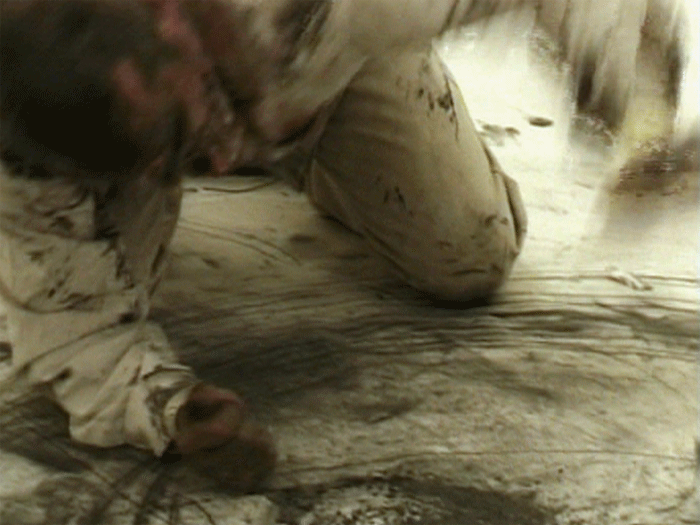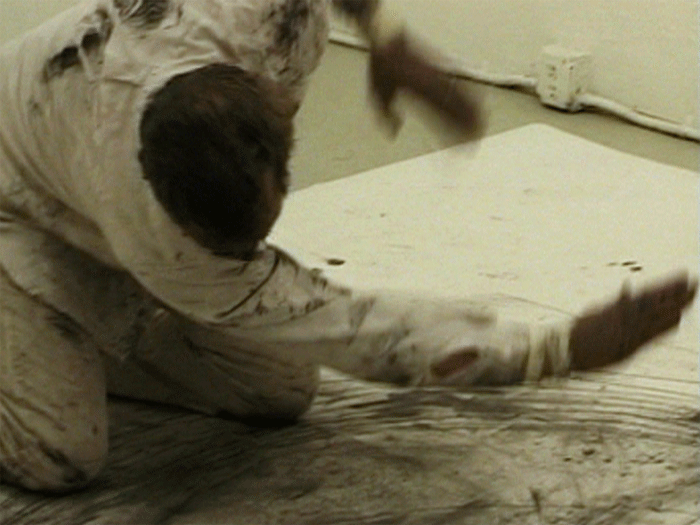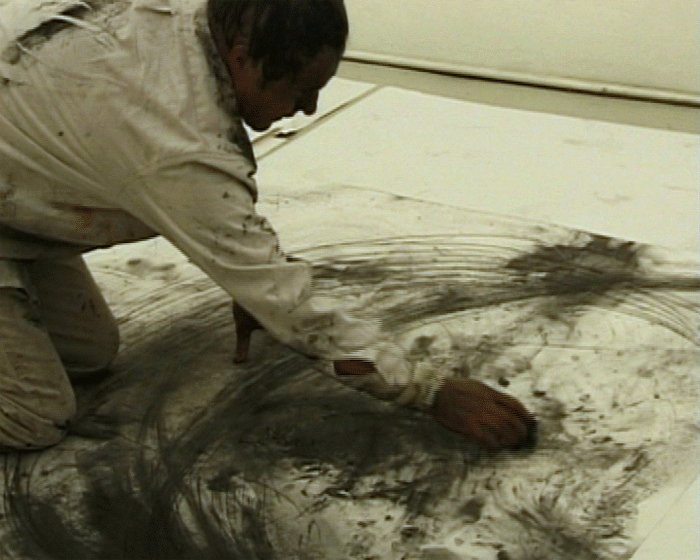


As with some of my work Sweating the Hole comes from an everyday event.
In the winter of 1995/6 we were plagued by an invasion of mice in our 300 year old house in east London. We had a large dog at the time, a Turkish Kangal, traditionally used in Turkey as a guard dog. Its diet was simple, and evidently attractive to mice. The situation rapidly deteriorated as the mice must have been breeding apace. Unfortunately all the hardware stores in the local area had run out of mouse traps. I did not want to use poison for fear of poisoning the dog. And in desperation I bought a rat trap thinking it might possibly work. The dog ate its evening meal regularly at 6 o’clock. It did not wolf down its food which was made up mostly of cereal but in a quiet fashion in keeping with its graceful and generally benign behaviour it would leave some food to eat later.
By this time I had spent several early evenings sitting in the kitchen and watching mice enjoy the free meals provided. They were bold , would approach within inches of my feet and if I made the slightest move they would rush over to the food bowl and disappear under the floor boards by way of a small space surrounding a central heating pipe. They were just too fast.
I placed the rat trap next to the food bowl and baited it with manchego cheese. The mice climbed on to the trap and ate the cheese. In desperation I tied a length of cotton thread to the trigger mechanism and then sat back in my chair to wait. Soon enough I saw what had become the baleful images of mice as they peered round the heating pipe. After wandering about eating the dog food and generally looking around and sniffing about they ventured on to the trap and approached the cheese. When one of them began to nibble on the cheese I pulled the cotton. There was an almighty bang and the trap sprang up at least a metre before falling to the ground. It shocked us all. The trap was lying on the ground and sticking out about half way along were the two back legs, tail and back part of the body of a mouse. Gingerly I lifted the trap to find that the mouse was dead but not attached to the trap.
I read the instructions for setting the trap and found that it was recommended that the trap should be nailed to the floor. Since the mouse had not been caught in the trap, did it die of fright, or was it killed outright by the trap falling on it? The absurdity of the scenario to which I was the main contributor did not pass me by.
I discovered that in Cabbalistic philosophy the mouse was regarded as a malevolent animal, causing injury to the tree of life by eating away at its roots. I had supposed mice to be relatively harmless, and was surprised to find their continual and regular presence changed my perception to where the mere sight of them was ominous and disturbing.
When I was musing over all this an invitation came to make a performance as part of an exhibition of British drawing .
The idea of the mouse hole came into my head and connected to a sense of the presence of absence in the form of a hole. Sweating the Hole comes out of these reflections. It lent itself to the idea of making a hole, of being in a hole, of traversing the edge of a hole as of the edge of nothing. The hole represents something like the place of the other, or it might be a part of the self which is unavailable to the conscious mind.
The performance attempts to draw a black hole through the analogy of the myth of mouse as a baleful entity. Sweating comes from physical exertion and is demonstrated in the performance. And it is a characteristic of fear.
In the performance I used graphite in powder form and compressed into drawing sticks. I used vaseline as a lubricant between the body and the surface of the paper. Each element in the performance advances and inhibits the opportunity for a clear resolution. For example I used vaseline to protect the skin as it came into contact with other surfaces, graphite , paper etc. Being largely made up of water, it acts against the qualities of vaseline. With the head freely lubricated with vaseline the sweat was isolated and could be easily squeezed out of the hair to fall on to the surface of the drawing. The vaseline ameliorated the graphite reducing its darkness somewhat and at the same time unifying the draughtsman with the surface of the drawing. This violent encounter between draughtsman and drawing surface also invites both positive aspects of the encounter to be registered as drawing, but at the same time it is insufficiently discrete and also impedes the process leading to a resolution. What seems to lie in the centre is the essential ambiguity of the whole event where at different times and in different ways both positive attributes and negative effects are in action. It would appear to be fundamental to the application of the dialectical mode of performance. What is conceived has to be overcome. Then there is no perceived end in view. There is however a limit on time i.e. a limit on mechanical time. The end arrives when the representation of blackness perceived as a hole is present on the surface of the paper. But as previously mentioned, it is not really black. The darkness indicates the probable presence of the illusion of hole. Then the paper is held up by the performer as an exhibit.
Also in my mind was and is the dark grey vacuum in the stomach region of a cadaver seemingly without entrails, painted by Rembrandt.
Stuart Brisley, 18th December 2009
Shoreditch